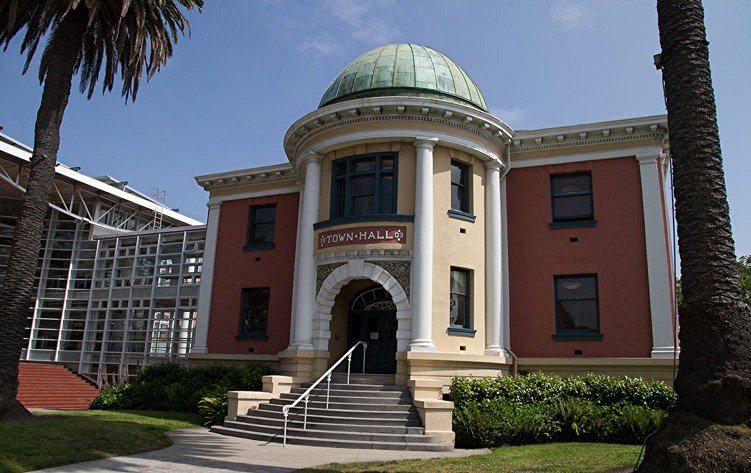

Emeryville, California is more than a brief Amtrak stop across the bay from San Francisco. On Tuesday evening all five Emeryville City Councilmembers approved an ordinance that increases the minimum wage for workers employed at small firms to $12.25 an hour, effective July 1. Employees at Emeryville companies with more than 55 employees, such as Home Depot and Ikea, will earn a minimum wage of $14.44 an hour, also to begin July 1.
“This is a momentous occasion for the city of Emeryville,” Jennifer Lin, deputy director of the East Bay Alliance for a Sustainable Economy, told Capital & Main by phone. “Many of the city councilmembers in their deliberations spoke about the need to address income inequality, to give workers a leg out of poverty.”
California’s current hourly minimum wage is $9, an increase of $1 over 2014. Meanwhile, the Golden State’s rate of poverty in 2013 was 23.4 percent,
» Read more about: Emeryville Joins Movement to Raise Minimum Wage »


“If we’re serious about fighting inequality, we need to understand it and track it to see how we’re doing,” Dr. Annette Bernhardt tells Capital & Main. Bernhardt is the lead author of Low Wage Work in California: 2014 Chartbook, the first of what will be an annual report from the University of California, Berkeley Labor Center. “Our goal was to show that the story of inequality isn’t just about the top one percent; it’s also about the millions of low-wage workers and their families who struggle with economic insecurity every day.”
Bernhardt and co-authors Ian Perry and Lindsay Cattell have assembled a detailed yet accessible profile of California’s low-wage workers – those earning less than $13.63 per hour in 2014, which is two-thirds of the state’s median hourly wage. A third of California workers, about 4.7 million, fell below that standard last year.
» Read more about: Report: State's Low-Income Workers Are Falling Behind »
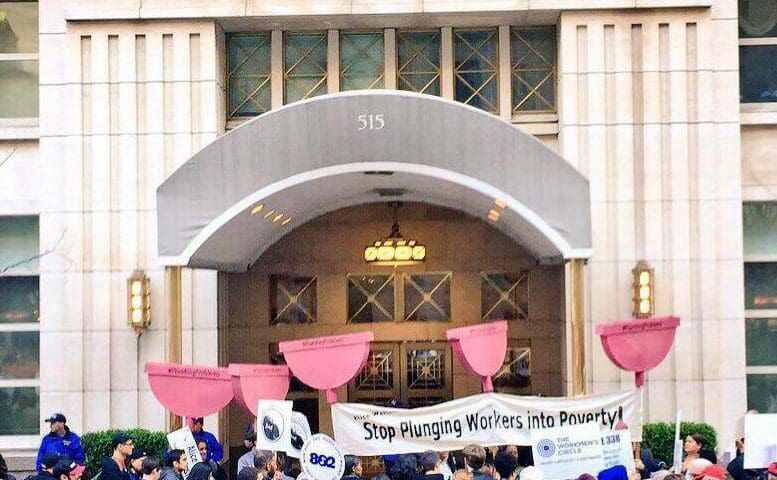

René Bobadilla had just started lunch on April 13 when he got a call from Walmart’s government relations office.
“I almost choked,” he says.
Bobadilla is the city manager of Pico Rivera and the government relations rep had just informed him that the local Walmart Supercenter was shutting down within hours and possibly for six months — due to a plumbing issue.
That meant 530 workers cut at Pico Rivera’s second-largest employer and a severe budget hit to the San Gabriel Valley city of 63,000. Sales tax from the Supercenter accounts for some 10 percent of city revenues — an estimated $1.4 million a year.
The nature of the problem is a mystery.
“They haven’t told us specifically — is it their main, do they have water coming out of their drain? I don’t know,” Bobadilla says.
The Pico Rivera store is one of five Walmart stores around the country suddenly closed due to vaguely defined plumbing problems.
» Read more about: Walmart's Pico Rivera 'Plumbing Problem' »
This year’s May Day events in Los Angeles are grouped around the themes of immigration reform and raising the minimum wage. Below is an updated list of events, provided by the Los Angeles May Day Coalition and other sources. Note: Michael Brown Sr., father of the teenager shot and killed last year in Ferguson, Missouri, will join the #MayDaySolidarity march meeting in Downtown L.A., at the Chinatown Gateway (Broadway & Cesar Chavez Ave.) shortly before 3 p.m. Tom Morello, activist, singer and guitarist for Rage Against the Machine and Audioslave, will join the march once it approaches the Metropolitan Detention Center (Aliso & Alameda streets) around 4 p.m.
Schedule of events:
2 p.m. – 3 p.m.: People gather at Dragon’s Gate, Chinatown, corner of Broadway & Cesar Chavez Ave.
3:15 p.m.– 3:45 p.m.: May Day Rally & program begins
Brief presentations and music. Speakers include elected officials such as L.A.
» Read more about: Tom Morello, Michael Brown Sr. to Join May Day Events »
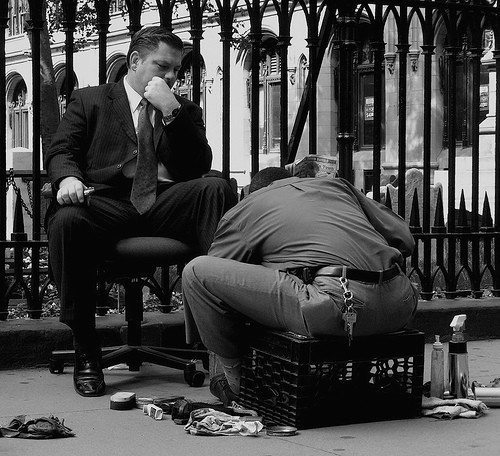

Charles Gladden has held his current job for eight years. The 63 year old sweeps floors, cleans dishes and mops bathrooms. His take-home pay is about $360 a week and he is currently homeless, moving between shelters and occasionally a Metro stop next to the White House.
Bertrand Olotara is a college graduate and a single father. After being laid off, he now earns $12 an hour as a cook and has a second job which often means he works up to 70 hours a week. Despite these two jobs, he is eligible for food stamps that help him feed his family.
These stories of America’s working poor aren’t anything new, but you may be surprised to learn where they work: the United States Senate. When the Senate privatized food service in their cafeterias and dining rooms, formerly living-wage jobs were converted into poverty-level positions through for-profit contractors like Restaurant Associates and Compass Group.

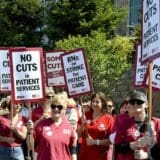
More than 5,000 registered nurses belonging to the California Nurses Association (CNA) are striking today at eight California hospitals, with a somewhat smaller number continuing the strikes Friday. The nurses are demanding that hospitals provide adequate staffing levels which are now, they claim, endangering patients. (Disclosure: CNA is a financial supporter of Capital & Main.)
Hospitals affected by the strike are: Los Angeles Medical Center (Kaiser Permanente); Providence Little Company of Mary Medical Center Torrance; Providence Saint John’s Health Center; Mills-Peninsula Health Services (Sutter); Sutter Auburn Faith Hospital; Sutter Roseville Medical Center; Sutter Santa Rosa Regional Hospital and Sutter Tracy Community Hospital.
Sue Robbins, a registered nurse who has worked at Sutter Roseville Medical Center for 14 years, says this is her first strike and it’s also the first time a strike has taken place at her hospital, located north of Sacramento.
Robbins says that a rehab center that served the community is gone and that Sutter’s management wants to eliminate “baby nurses” —
» Read more about: Nurses at Eight California Hospitals Strike to Demand Adequate Staffing »
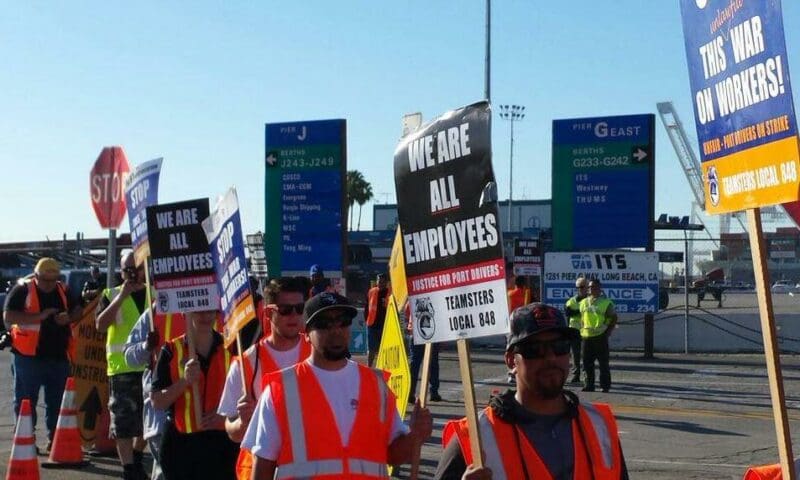
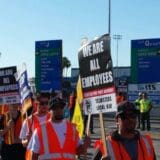
As the strike by a couple hundred harbor truck drivers enters its third day, work stoppages have spread to a Union Pacific rail yard located in Lincoln Heights, just east of downtown Los Angeles. A rally will be held there today, Wednesday, April 29, to protest the theft of the drivers’ wages by port hauling firms. It takes place 2:30-4 p.m. at the Union Pacific Railroad Trailer and Container Intermodal Facility, 1041 Richmond Street.
At the heart of the dispute is the continuing fight of short-haul drivers to be classified as company employees by the trucking firms they work for. Currently, most drivers are considered “independent contractors,” a job category that denies the drivers basic labor benefits and rights, while placing on them the costly burden of paying for the maintenance, fuel and insurance for their vehicles.
On Monday, drivers for Pacific 9 Transportation, Intermodal Bridge Transport,
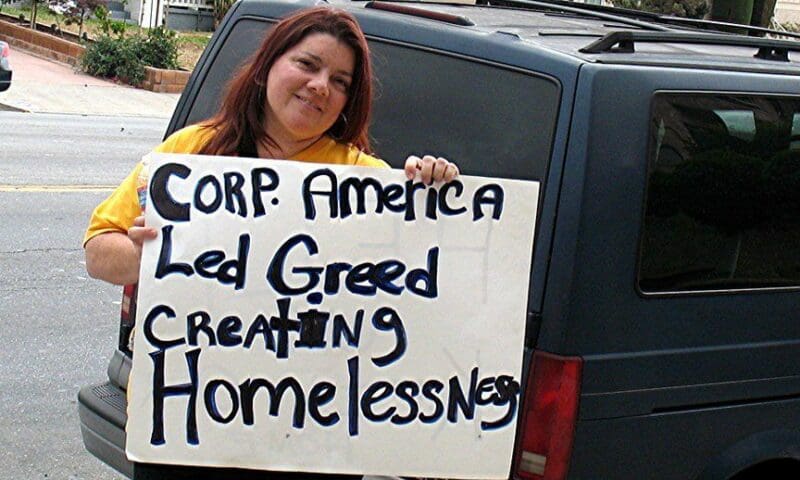

For Catherine Green, home for the last three decades has been a comfortable apartment in the sprawling 43-unit Boulevard Villa near Crenshaw and Venice boulevards in Mid-City Los Angeles. Her alert gaze, energetic demeanor and perfect posture give no hint of a life that’s spanned 90 years. “I was one of the first people to move in here,” she says with a strained smile. “I’ve seen ’em come, and I’ve seen ’em go. This is my community, my village.”
Tanya Rhodes, a retired nurse, and her disabled daughter also call this place home, and have done so for the last 22 years. Louis Gates, a sturdy man with a steely glare, is a Vietnam vet who relocated here five years ago. Between nervous puffs on a cigarette, he expresses how happy he was when he moved in, and says sadly, “I thought this was going to be the last place I would move into.” If the winds of fortune do not change soon,
» Read more about: As L.A.'s Rents Rise: Crenshaw Tenants Battle Eviction »


The day after undergoing complicated surgery for pancreatic cancer, a friend’s 76-year-old-husband became combative and aggressive while being cared for in an Intensive Care Unit. He stood up, tore out his IV and nasal gastric tubes, and pushed the nurse who had come to get him to lie down. Eventually he had to be tied down to his bed with hand and foot restraints because he was kicking and thrashing about – even kicking his wife in the stomach. Not the type of scene we expect in an ICU.
For nurses these days, however, it seems that assaults and acts of violence have become part of the job. According to Christy McConville of the United Nurses Associations of California, workplace assaults are now being captured on video and shared on social media, creating a new awareness of the problem.The federal Bureau of Labor Statistics reports that violence against hospital workers is nearly five times greater than against average workers in all other employment categories combined – and it seems to be rising.
» Read more about: Urgent Care: Protecting Nurses Against Workplace Violence »


Maria Bustillos and Elizabeth Fladung discuss their experiences reporting on the pervasiveness of food deserts in the midst of California’s food production heartland.
This podcast is an encore posting from our State of Inequality series.
Maria Bustillos is a journalist and critic living in Los Angeles.
Elizabeth Fladung is a Brooklyn-based, CalArts-trained photojournalist. Her work has appeared in The Nation, La Repubblica, The Fader and Wax Poetics Magazine.
» Read more about: Going Down Highway 99 Feeling Sad (and Hungry) »


Maria Bustillos and Elizabeth Fladung discuss a day spent exploring inequality in Bakersfield, “The India of the U.S.,” and a very interesting person they met along the way.
This podcast is an encore posting from our State of Inequality series.
Maria Bustillos is a journalist and critic living in Los Angeles.
Elizabeth Fladung is a Brooklyn-based, CalArts-trained photojournalist. Her work has appeared in The Nation, La Repubblica, The Fader and Wax Poetics Magazine.
» Read more about: Podcast: Hope and Hopelessness in Bakersfield »


In The Public Interest made a big splash a few years ago with our report that showed many private prison contracts include a “lockup quota,” also known as a bed guarantee, which ensures high levels of taxpayer funds go to corporations even when prison populations decline. When states agree to 80 percent, 90 percent or even 100 percent occupancy guarantees, policymakers are disincentivized from the kind of sentencing reform we desperately need to pass.
But the federal government is currently giving a different kind of guarantee to prison companies, one that not only guarantees profits but doesn’t make us safer. It’s known as the “Immigrant Detention Quota” and it’s helping make GEO Group and the Corrections Corporation of America (CCA) a lot of money. According to a new report from Grassroots Leadership, the two largest private prison companies in the U.S. now run 70 percent of the ICE Detention System and are working hard to expand that share.
» Read more about: Jailhouse Shock: U.S. Fattens Profits of Private Immigrant Prisons »
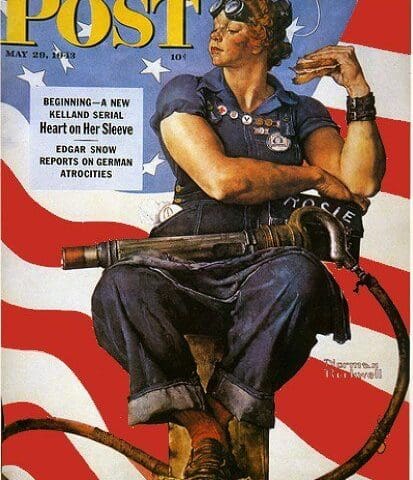

She was the perfect patriotic icon: Sassy yet dignified, brawny yet feminine – a massive rivet gun cradled on her lap, feet resting on a copy of Mein Kampf. And all the while she holds a sandwich as Old Glory ripples in the background. Mary Doyle Keefe, a Vermont telephone operator who posed for Norman Rockwell’s immortal Rosie the Riveter painting, first publicly seen on a 1943 Saturday Evening Post cover, died Tuesday at the age of 92. At the time of her brush with fame, Keefe was Rockwell’s neighbor and a little embarrassed that the artist had pumped iron into the painted arms of the petite 19-year-old.
Rosie the Riveter had too much whimsy and restraint for it to fade into kitsch or agitprop oblivion. Like J. Howard Miller’s equally famous “We Can Do It!” poster, with which it is sometimes confused,
» Read more about: ‘Rosie the Riveter’ Model Dies — Rockwell Painting Owned by Walmart Museum »


Maria Bustillos shares her thoughts on our country’s failure to invest in higher education access and the mounting toll it is taking on students today.
This podcast is an encore posting from our State of Inequality series.


California’s Chamber of Commerce is best known for its Job Killers list, which the king of business lobbies uses to scare off state legislators from passing laws that might, among other things, protect workers from wage theft or force oil companies to pay extraction taxes. (In reality, the Job Killers list is more of a bill-killers list.) But the CalChamber isn’t all about killing. Last week it revealed its kinder, if not gentler, side in the form of a Job Creators list. (Who knew?) The lawmaking season is still young, but already the CalChamber has begun identifying bills that it claims will allow more Californians to enter the workforce.
* * *
It’s not entirely clear what jobs, if any, would be created by Corporate Democrat Adam Gray’s bill,


Elizabeth Fladung’s photos of San Francisco in the midst of the tech boom offer a study in contrasts.
This slideshow is an encore posting from our State of Inequality series.Elizabeth Fladung is a Brooklyn-based, CalArts-trained photojournalist. Her work has appeared in The Nation, La Repubblica, The Fader and Wax Poetics Magazine.


The religious spring festivals of Passover and Easter are behind us. We’ve paid our taxes. Congress has passed another bill to give the top two-hundredths of one per cent another windfall. I think a big-picture look at the structure of this economy might help us all take a deep breath. If my guess is correct, we’ll need it for the work ahead. This kind of economy stands on three legs: raw materials, cheap labor and as little regulation from government as possible.
Raw materials were the reason why Europe’s empires stumbled across the Western hemisphere in the first place. Looking for an easier route to the profitable spice markets of the East Indies, the Spanish found the West Indies and began a centuries-long exploration and exploitation of everything it uncovered. Extraction of natural resources – from tomatoes to gold to, one day, black gold – led those powers to exploit South and Central America as well as Africa,
» Read more about: Three Legs of the Economy: The Past Is Prologue »
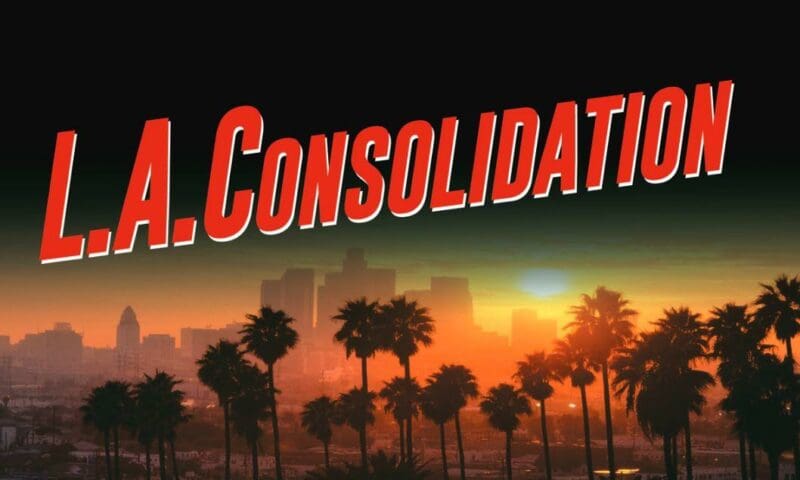

Fourteen months ago, media giant Comcast announced its plan to buy Time Warner Cable, a merger that would give one company control of 30 percent of television distribution and at least half of high-speed Internet distribution nationally. Here in L.A. County, Comcast would serve 96 percent of residents and, for 72 percent of those residents, it would be the only choice for broadband at speeds of 25 Mbps or faster. This level of national and local consolidation has brought together a broad range of consumer organizations, content creators, programmers and organizations representing diverse communities to oppose this merger. On April 14, these organizations came before the California Public Utilities Commission (CPUC) at a hearing in downtown Los Angeles to urge state regulators to say no to this deal.
Why is there such opposition? For starters, if the merger is approved Los Angeles residents are almost certain to face higher prices and anti-consumer policies that limit their access to content.
» Read more about: Why the Comcast-Time Warner Cable Merger Is a Bad Deal for Los Angeles »


Last week the Long Beach City Council unanimously approved a citywide Project Labor Agreement, the first major initiative increasing standards on publicly funded construction projects and increasing access to apprenticeship programs for Long Beach residents. As the saying goes, “It was a long time comin’.”
For decades, community groups and construction trade unions advocated for greater accountability on public works projects to ensure contractors are paying prevailing wages and maximizing local dollars by providing career opportunities for local residents. According to our allies at the L.A. and Orange Counties Building and Construction Trades Council, advocates pushed for previous Mayor Bob Foster to consider a Project Labor Agreement policy but he didn’t budge. In fact, time and time again, the proposal sat on his desk during his eight-year tenure and never saw the light of day. A few victories were accomplished during the Foster administration, including an agreement on the Gerald Desmond Replacement Bridge.


Remunicipalization is big word for a simple concept: It’s the process of bringing a formerly privatized service or asset back under public control. For residents and taxpayers, remunicipalization is often the logical conclusion after private water corporations fail to deliver on their promises. For corporations like Veolia and Suez that earn profits from taking over municipal water systems, remunicipalization is a major threat to their business model. And that threat is growing every year.
According to a new book from the Transnational Institute and other organizations, the rate of remunicipalization is “accelerating dramatically”:
“Over the last 15 years, 235 cases of water remunicipalization have been recorded in 37 countries, impacting on more than 100 million people. Moreover the pace of remunicipalization is accelerating dramatically, doubling in the 2010-2015 period compared with 2000-2010.”
City leaders and residents across the globe are reclaiming their water systems from private profiteers and ensuring that access to clean water remains a human right for every citizen.